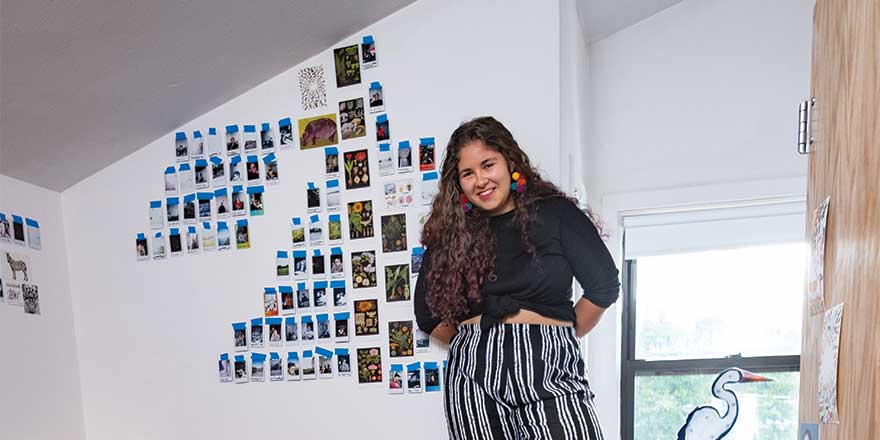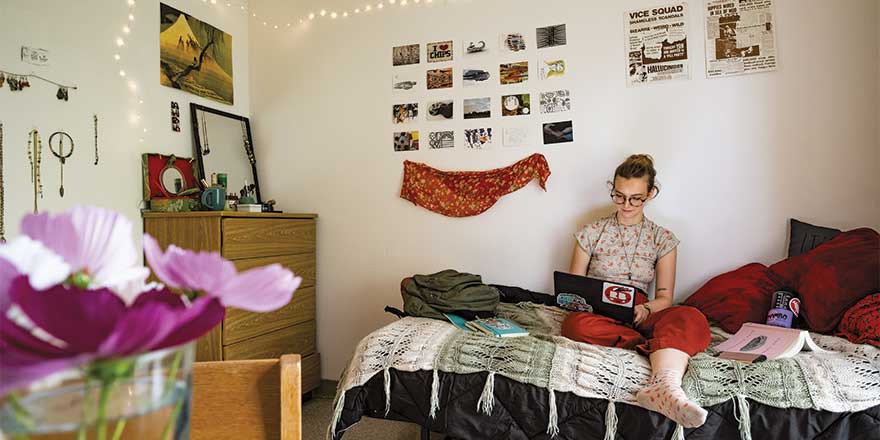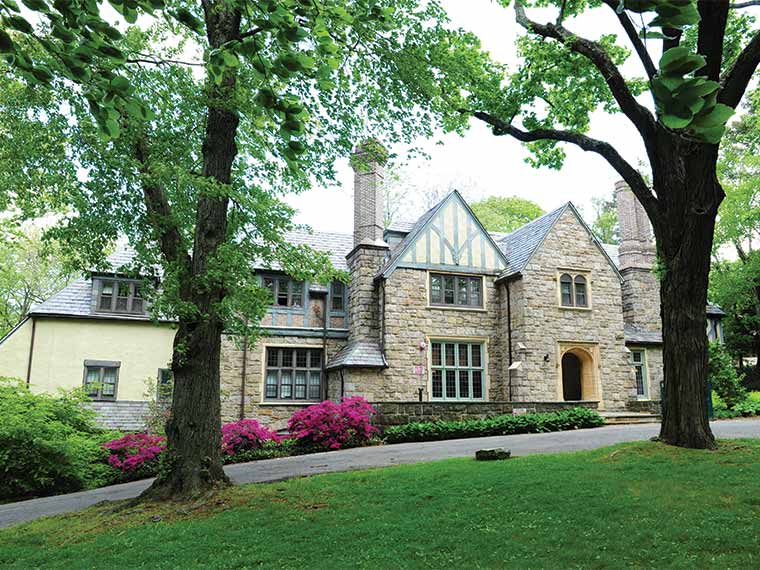
Sarah Lawrence College is almost entirely residential, creating a community where living and learning blend seamlessly together.
above: after film class, Kaitie Dilan longboards home to the Social Justice Co-op.
Walking around the Sarah Lawrence campus, it’s easy to assume everyone knows each other—after all, it’s hard to walk across campus without at least a few friendly waves and lunch invitations.
Current students, even those in their junior or senior year, remember feeling intimidated by the prospect of making friends in college; to many, high school friends were longstanding fixtures of their social worlds, and starting over seemed daunting. For many students, their first friends at SLC are the ones they meet down the hall.
SLC students aren’t split up by academic interest, in either classes or living spaces, so there’s an opportunity to meet friends from across interests and backgrounds, creating a diverse community full of kind people who are also interesting to talk to.
“We have a diverse student body in terms of interests, so it’s great having diversity in housing as well,” said Jordan Foster, a resident adviser (RA) at Hill House. “And as you grow and your personality develops, you get better at determining which living situation suits you.”
When you have a student body seeking such an individualized education, it’s rare to find two students looking for the exact same living style, which is why SLC offers a variety of dorm styles—no two communities are entirely alike, but a few are a bit more thematic than others. There are three cooperative houses, or co-ops, at Sarah Lawrence, each centered around a common theme: sustainability, social justice, and intersectionality.
These collectives bring together students who share ideas about how they want to live and use their space. Warren Green, which houses the sustainability co-op, has solar panels and composts for a community garden, while the social justice co-op in Andrews Court holds events to foster dialogue around activism.
“The social justice co-op is 12 people with a shared kitchen and living spaces,” student Kaitie Dilan explained. “We all have wildly different schedules, but there’s always someone cooking—this is my favorite residential experience so far.”
Students living in co-ops share household responsibilities, including cooking and cleaning, presenting an opportunity to try out “real life” living with a safety net.
“It’s sort of like living at home with parents, but not at all,” Kaitie said. “You’re learning how to be around people in a very different way, sharing a budget, sharing food.”
Just as Sarah Lawrence faculty are an experienced and engaged presence for students, RAs live in every residence community to facilitate happy, healthy cohabitating.
“No matter where you’re coming from, no matter what high school, it is a transition,” Jordan said. “So it can be a little rocky at first. But the most important thing—I think this is especially true of SLC—is that there are so, so many people looking out for you.”
Part of Jordan’s RA responsibilities is making sure his residents are aware of the many resources SLC has to support students, from academic tutoring to mental health counseling.
“The list of people you can turn to for advice here is pretty long: your RAs of course, your dons, any faculty member really, the Health & Wellness office, folks in Residential Life—there are so many people,” Jordan said. “I try to make my residents aware of all the resources. I won’t have the answers to all your problems, but someone on campus will.”
Not every student is sure where they want to live coming into their first year, but Kaitie shares a common sentiment: “I didn’t know where I wanted to live, but I ended up where I needed to live.”
 above Hazel Pritchard settles in for an afternoon of studying in Rothschild, where she shares a kitchen and common space with friends
above Hazel Pritchard settles in for an afternoon of studying in Rothschild, where she shares a kitchen and common space with friends
How are roommates decided?
Some students pair up over the summer on group chats, but plenty are paired the old-fashioned way: via surveys that assess things like neatness, sleep schedules, and study area preferences. Residential Life staff then hand-pick roommates based on compatibility. Roommate introductions go out over email before the term starts.
Will I share a bathroom?
Most students share a bathroom with two to five people, but it all depends which house you’re living in.
Can I cook?
Yes! Almost all the houses on campus have kitchens accessible to students, in addition to our dining services.
Is campus safe?
Yes, we have a 24/7 public safety team, a blue light system, several campus shuttles, and more.
Do all first-years live on campus?
Yes! And about 90% of all students live on campus.
Photography: Don Hamerman unless otherwise noted.
You're learning how to be around people in a very different way, sharing a budget, sharing food.

Tweed House is a converted Tudor-style, single-family home that houses 19 students. Tweed has a kitchen and a backyard where students picnic and study on sunny days. Photo: Chris Taggart.